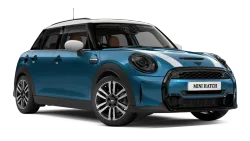

Used Mini Hatch for Sale in Portugal
Discover a wide selection of used Mini Hatch cars for sale in Portugal. Browse our extensive listings to find competitive prices and great deals. Your perfect Mini Hatch is just a click away!
The Mini Hatch Generation 2, commonly referred to as the R56, marked a significant evolution in the iconic British marque's design and technology. Introduced in 2006, the R56 was engineered to maint...
Technical Specifications
Select Version
Dimensions
Engine
Driving
Others
History and Features
Mycarro AI
Apr 26, 2025
The Mini Hatch Generation 2, commonly referred to as the R56, marked a significant evolution in the iconic British marque's design and technology. Introduced in 2006, the R56 was engineered to maintain the charm of the original Mini while introducing more modern features and enhanced performance. The facelift version, released in 2010, brought subtle yet impactful improvements that would continue to attract enthusiasts and casual drivers alike.
Design Updates and Exterior Features
The facelift of the R56 introduced several design updates that distinguished it from its predecessor. One of the most noticeable changes was the new headlight design, which saw a more angular and aggressive look. The rear lights were also redesigned, featuring a circular LED light signature that became a hallmark of the updated Mini aesthetic. Additionally, the front grille was enlarged, giving the car a sportier appearance and enhancing airflow to the engine.
These exterior modifications not only contributed to a more modern look but also included the introduction of new color options and wheel designs that allowed customers to personalize their Minis further. The balance of retro charm with contemporary styling continued to resonate with fans of the brand, ensuring that the Mini Hatch remained a fashionable choice among compact cars.
Interior Improvements and Technology
Inside the R56, the facelift model showcased considerable technological upgrades. The most significant was the introduction of the new Mini Connected system, which allowed drivers to link their smartphones seamlessly to the car, providing access to music, navigation, and even social media notifications on the vehicle’s display screen. The inclusion of high-quality materials and refined finishes elevated the overall cabin ambiance, making it feel more upscale and comfortable.
One of the standout features of the interior was the central speedometer, a nod to the original Mini design but with modern functionality. The digital interface allowed for easy readability while accommodating essential information about the vehicle’s performance, further blending heritage with innovation in one unified design.
Enhanced Performance and Engine Options
Under the hood, the facelift R56 offered various engine options designed to enhance both performance and efficiency. The lineup included the familiar 1.6-liter petrol engine options, which saw improvements in terms of fuel efficiency and reduced emissions. The addition of the more powerful Mini Cooper S, featuring a turbocharged variant of the engine, provided an exhilarating driving experience that appealed to performance enthusiasts.
The R56's refined suspension system delivered a balanced ride quality, enabling agile handling while retaining comfort during everyday drives. Improvements in steering responsiveness made the raucous Mini experience even more engaging, ensuring that it was not just a vehicle for practicalities, but a true driver's car.
Safety and Reliability
The facelift 2010 R56 was also commended for its enhanced safety features, reflecting the growing importance of safety regulations in automotive design. The inclusion of advanced technologies such as stability control and more robust airbag systems contributed to better crash test ratings compared to its predecessor. This bolstered reliability and provided confidence for drivers and passengers alike, making it a safer choice for city commutes and longer road trips.
Sales and Market Reception
Upon its release, the facelift R56 found favor in the market, with strong sales figures reflecting widespread consumer interest. Variants such as the Mini John Cooper Works continued to capture the imagination of driving enthusiasts, while the standard models appealed to a broader audience looking for a stylish and practical compact car. Customization options allowed buyers to express their unique personalities, leading to diverse models on the road.
Legacy and Influence
The Mini Hatch Generation 2 (R56) facelift of 2010 ultimately solidified the brand’s position as a key player in the compact car market. The fusion of stylish design, modern technology, and spirited performance resonated with a generation that sought both classic charm and forward-thinking innovation in a car. As Mini progressed beyond the R56, the lessons learned and the benchmarks set during this generation would influence future models, ensuring that the spirit of Mini continues to thrive.
